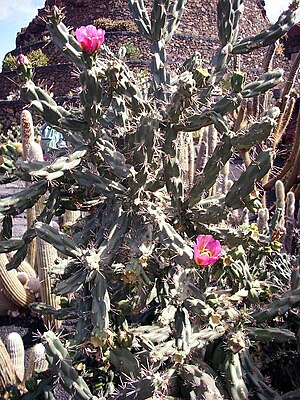Cylindropuntia imbricata
| Cylindropuntia imbricata | ||||||||||||
|---|---|---|---|---|---|---|---|---|---|---|---|---|

Cylindropuntia imbricata |
||||||||||||
| Systematics | ||||||||||||
|
||||||||||||
| Scientific name | ||||||||||||
| Cylindropuntia imbricata | ||||||||||||
| ( Haw. ) FMKnuth |
Cylindropuntia imbricata is a plant from the genus of the cylindrical prickly pears ( Cylindropuntia ) in the family of cactus (Cactaceae). The epithet of the species means roof tile shaped . Foreign language trivial names are "Abrojo", "Candelabrum Cactus", "Cane Cactus", "Cane Cholla", "Cardenche", "Cardón", "Coyonostle", "Joconostle", "Tesajo", "Tesajo", "Tesajo Macho" , "Tree Cholla", "Vela de Coyote" and "Xoconostle".
description
Cylindropuntia imbricata grows tree-like up to 3 meters and more and often forms a woody trunk with age. The branches are diagonally apart, often pointing upwards. The strongly humped end links are about 2 to 3 inches long. The humps themselves are 2 to 2.5 inches long and flattened on the sides. The 8 to 30 thorns are up to 3 inches long. They are brown with thin sheaths.
The 4 to 6 centimeters long and up to 9 centimeters wide, dark pink to magenta or reddish magenta colored flowers appear on the cylindrical to club-shaped shoot ends. The also strongly tuberous fruits are 2 to 4.5 centimeters long, obovate, thornless and yellow. They reach a diameter between 2 and 4 centimeters.
Distribution, systematics and endangerment
Cylindropuntia imbricata is native to the US states of Colorado , Texas , Oklahoma and New Mexico, as well as all of central Mexico . The species is hardy in southwest Kansas . Cylindropuntia imbricata is one of the cacti already living in the wild in Europe. Populations are occasional in Switzerland and France, while the species is already considered established in Spain. It was introduced in South Africa at the beginning of the 20th century and is widespread throughout the country with the exception of Natal Province . Cylindropuntia imbricata is one of the cactus species that are biologically controlled as weeds.
The following species and varieties are synonyms :
Cereus imbricatus Haw. (1821), Opuntia imbricata (Haw.) DC. (1828), Cactus imbricatus (Haw.) Lem. (1868), Opuntia arborescens Engelm. (1848), Cylindropuntia arborescens (Engelm.) FMKnuth (1930), Opuntia imbricata var. Arborescens (Engelm.) Less (1970) (nom. Inval. ICBN -Article 33.3), Cylindropuntia imbricata var. Arborescens (Engelm.) Bulot ( 2002), Opuntia exuviata-stellata Lem. (1853), Opuntia vexans Griffiths (1912), Opuntia imbricata var. Vexans (Griffiths) Less (1970) (nom. Inval. ICBN -Article 33.3), Opuntia cardenche Griffiths (1908), Cylindropuntia cardenche (Griffiths) FMKnuth (1936) , Opuntia imbricata var. Cardenche (Griffiths) Bravo (1972), Cylindropuntia imbricata subsp. cardenche (Griffiths) U. Guzman (2003), Opuntia lloydii Rose (1909), Opuntia imbricata var. lloydii (Rose) Bravo (1972), Cylindropuntia imbricata subsp. lloydii (Rose) U. Guzman (2003), Opuntia imbricata var. argentea M.S. Anthony (1956) and Cylindropuntia imbricata subsp. argentea (MSAntony) and Guzman (2003).
A distinction is made between the following varieties :
-
Cylindropuntia imbricata var. Imbricata :
The first description was as Cereus imbricatus and was published in 1821 by Adrian Hardy Haworth . Frederik Marcus Knuth placed them in the genus Cylindropuntia in 1935 . The variety grows tree-shaped with small shoot segments. -
Cylindropuntia imbricata var. Argentea (M. Anthony) Backeb.
The first description was as Opuntia imbricata var. Argentea and was published in 1956 by Margery Stuart Anthony . Curt Backeberg placed them in the genus Cylindropuntia in 1958 . The variety grows more shrub-like with large shoot segments.
In the Red List of Threatened Species of the IUCN , the species is listed as " Least Concern (LC) ". H. listed as not endangered.
proof
literature
- Edward F. Anderson : The Great Cactus Lexicon . 2nd Edition. Eugen Ulmer KG, Stuttgart 2011, ISBN 978-3-8001-5964-2 , pp. 172 .
- Alwin Berger : Cacti - instructions for culture and knowledge of the most important introduced species . Eugen Ulmer, Stuttgart 1929, p. 62 .
- NL Britton , JN Rose : The Cactaceae. Descriptions and Illustrations of Plants of the Cactus Family . tape I . The Carnegie Institution of Washington, Washington 1923, p. 63 ff . ( online ).
- Franz Essl, Johannes Kobler: Spiny invaders - Patterns and determinants of cacti invasion in Europe . In: Flora - Morphology, Distribution, Functional Ecology of Plants . Volume 204, number 7, 2009, pp. 485-494, doi : 10.1016 / j.flora.2008.06.002 .
- William Jackson Hooker : Curtis' Botanical Magazine . Vol. XV. Royal Botanic Garden of Kew, London 1842, p. 299-301 .
- Brian Loflin, Shirley Loflin: Texas Cacti . TAMU nature guide, 2009, ISBN 1-60344-108-5 , p. 65 .
- VC Moran, HG Zimmermann: Biological control of cactus weeds of minor importance in South Africa . Volume 37, Numbers 1-3, 1991, pp. 37-55, doi : 10.1016 / 0167-8809 (91) 90138-N
- Karl Schumann : Complete description of the cacti (Monographia cactacearum) . J. Neumann, Neudamm 1899, p. 668 ( online ).
Individual evidence
- ^ Franz Essl, Johannes Kobler: Spiny invaders - Patterns and determinants of cacti invasion in Europe . 2009, p. 488.
- ^ VC Moran, HG Zimmermann: Biological control of cactus weeds of minor importance in South Africa . 1991, pp. 42-44.
- ^ Adrian Hardy Haworth : Revisiones Plantarum Succulentarum , London 1821, p. 70.
- ^ Curt Backeberg , Frederik Marcus Knuth : Cactus ABC. En haandbog for fagfolk and amatører . Copenhagen 1935, p. 125 .
- ^ M. Anthony: The American Midland Naturalist , Vol. 55, 1956, p. 236
- ^ Curt Backeberg : Die Cactaceae: Handbuch der Kakteenkunde . 2nd Edition. tape I . Gustav Fischer Verlag, Stuttgart New York 1984, ISBN 3-437-30384-8 , p. 194 .
- ↑ Cylindropuntia imbricata in the IUCN Red List of Threatened Species 2014.1. Posted by: Hernández, HM, Cházaro, M. & Gómez-Hinostrosa, C., 2013. Retrieved June 12, 2014.
